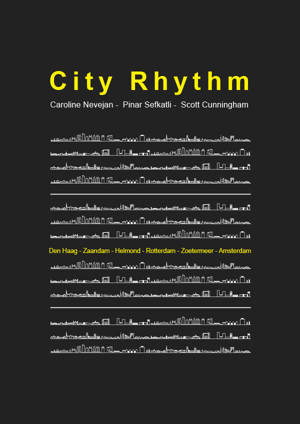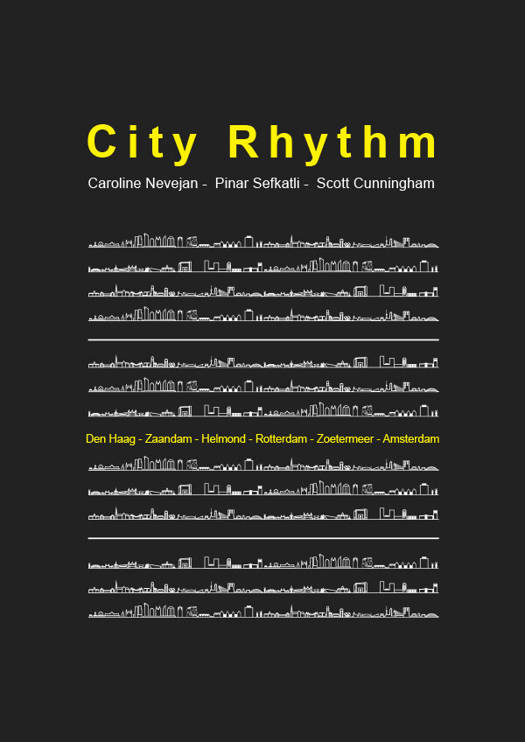
- Retrait gratuit dans votre magasin Club
- 7.000.000 titres dans notre catalogue
- Payer en toute sécurité
- Toujours un magasin près de chez vous
- Retrait gratuit dans votre magasin Club
- 7.000.0000 titres dans notre catalogue
- Payer en toute sécurité
- Toujours un magasin près de chez vous
29,95 €
+ 59 points
Description
Rhythm is fundamental to life. Rhythm can be perceived in the movement of the sun, the moon and the stars. Rhythm makes our hearts tick and defines our breath, in and out. And even the smallest particle in a microbe is part of rhythmic movements. Rhythm in activities is important for culture, for religion, and for sports, schools and hospitals for example. Yet in social situations, social analyses and in social policymaking, rhythm is not considered as a space of analyses or a space of design.
City Rhythm explores the potential of using rhythm analyses in the physical world and related data domain for enhancing social safety in neighbourhoods in the Netherlands. Rhythm in the physical world happens both in space as well as in time. Rhythm in data can connect to location (instead of persons), thus circumventing the issue of privacy. However, because the data addresses specific times and places, nonetheless the data still addresses significant social issues.
Founded in the social sciences, humanities, arts and computer science, the interdisciplinary research team also includes civil servants of six cities in the Netherlands who have engaged throughout the research. With the help of students, nine case studies are carried out.
Building upon methodologies from the social sciences and architecture, it is found that in seven cases rhythm analyses identified new design solution spaces. As a result, a methodology for doing rhythm analyses in the physical world is developed. More theoretical and artistic explorations are carried out. These enable the bridging of experience and insight from rhythm analyses to the data world.
The interdisciplinary research team formulates the basic concept and terminology for the City Rhythm Data Model (CRDM). This consists of beats, base and street rhythms. Beats are defined by the state of specific area at a specific moment in time, As an example of a state, a street might have lots of cars, few cars, or no cars at all. Street rhythms show significant transitions over time for the specific area. The base rhythm of an area is defined by comparison to other areas. These derived rhythms are like a musical meter. In this specific context, individual street rhythms develop. Street rhythms represent a variation around a few specific themes.
The City Rhythm Data Model (CRDM), based on mixtures of hidden Markov models, is built and run with open and linked data from the Central Bureau for Statistics (CBS) of the Netherlands. Areas can be represented using sizes in different datasets. City Rhythm worked with areas of 500 by 500 meters.
The choice of datasets is defined by mapping upon the YUTPA framework which indicates trade-offs for trust. In the validation session of the City Rhythm Data Model it is concluded that the general experience of social safety of specific areas is reflected in CRDM base rhythms. For being able to understand which specific data constitute a beat (or "state") and for understanding specific street rhythms, further research is necessary. In conclusion to the one year exploratory study, City Rhythm indicates that rhythm analyses, in the physical world as well as in the related data domain, offer a potential new approach for policymaking.
City Rhythm explores the potential of using rhythm analyses in the physical world and related data domain for enhancing social safety in neighbourhoods in the Netherlands. Rhythm in the physical world happens both in space as well as in time. Rhythm in data can connect to location (instead of persons), thus circumventing the issue of privacy. However, because the data addresses specific times and places, nonetheless the data still addresses significant social issues.
Founded in the social sciences, humanities, arts and computer science, the interdisciplinary research team also includes civil servants of six cities in the Netherlands who have engaged throughout the research. With the help of students, nine case studies are carried out.
Building upon methodologies from the social sciences and architecture, it is found that in seven cases rhythm analyses identified new design solution spaces. As a result, a methodology for doing rhythm analyses in the physical world is developed. More theoretical and artistic explorations are carried out. These enable the bridging of experience and insight from rhythm analyses to the data world.
The interdisciplinary research team formulates the basic concept and terminology for the City Rhythm Data Model (CRDM). This consists of beats, base and street rhythms. Beats are defined by the state of specific area at a specific moment in time, As an example of a state, a street might have lots of cars, few cars, or no cars at all. Street rhythms show significant transitions over time for the specific area. The base rhythm of an area is defined by comparison to other areas. These derived rhythms are like a musical meter. In this specific context, individual street rhythms develop. Street rhythms represent a variation around a few specific themes.
The City Rhythm Data Model (CRDM), based on mixtures of hidden Markov models, is built and run with open and linked data from the Central Bureau for Statistics (CBS) of the Netherlands. Areas can be represented using sizes in different datasets. City Rhythm worked with areas of 500 by 500 meters.
The choice of datasets is defined by mapping upon the YUTPA framework which indicates trade-offs for trust. In the validation session of the City Rhythm Data Model it is concluded that the general experience of social safety of specific areas is reflected in CRDM base rhythms. For being able to understand which specific data constitute a beat (or "state") and for understanding specific street rhythms, further research is necessary. In conclusion to the one year exploratory study, City Rhythm indicates that rhythm analyses, in the physical world as well as in the related data domain, offer a potential new approach for policymaking.
Spécifications
Parties prenantes
- Auteur(s) :
- Editeur:
Contenu
- Nombre de pages :
- 178
- Langue:
- Anglais
Caractéristiques
- EAN:
- 9789081983914
- Date de parution :
- 09-11-18
- Format:
- Livre broché
- Dimensions :
- 210 mm x 297 mm
- Poids :
- 533 g

Les avis
Nous publions uniquement les avis qui respectent les conditions requises. Consultez nos conditions pour les avis.






